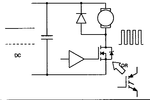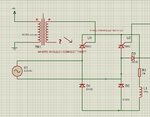saraaj100
Junior Member level 1
- Joined
- Sep 24, 2010
- Messages
- 18
- Helped
- 0
- Reputation
- 0
- Reaction score
- 0
- Trophy points
- 1,281
- Location
- Chennai, India
- Activity points
- 1,406
Hello...I want to chop the DC so that 585VDC into 400VDC. I dont know How to Connect the gate of IGBT w.r.t Emitter. Because Emitter here is not at zero or Grounded, Its floating. The ground of Microcontroller connection should NOT be mixed with the high voltage section.
Suggest me a circuit to Trigger the IGBT in this configuration. Triggering may be used with pulse transformer or GATE DRIVER from ST like L6390 or IR21XX or Opto-Coupler. I need a isolated Triggering from Microcontroller.

Is it possible or not. Help me with a Gate trigger circuit.
Suggest me a circuit to Trigger the IGBT in this configuration. Triggering may be used with pulse transformer or GATE DRIVER from ST like L6390 or IR21XX or Opto-Coupler. I need a isolated Triggering from Microcontroller.

Is it possible or not. Help me with a Gate trigger circuit.

